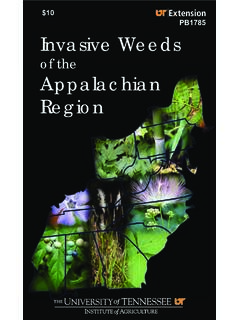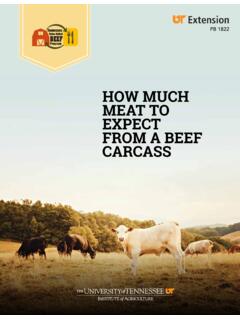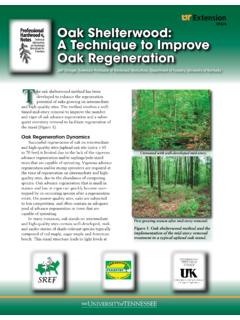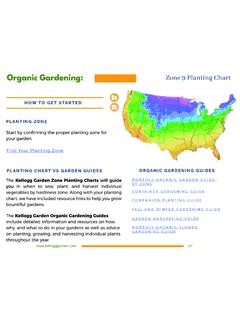Transcription of THE TENNESSEE VEGETABLE GARDEN
1 BACKYARD VEGETABLES | THE TENNESSEE VEGETABLE GARDEN - GARDEN Planning, Plant Preparation and Planting1 THE BACKYARD SERIESBACKYARD VEGETABLESW 346-BVegetable production is increasingly popular for TENNESSEE residents. Growing vegetables at home provides financial and nutritional benefits through the bounty of a fresh harvest, and the activity enhances personal health and well-being. However, a basic understanding of soils, site selection and crop maintenance is required before backyard growers can take full advantage of these benefits of home food production. To meet these needs, this series of fact sheets has been prepared by UT Extension to inform home gardeners and propel them to success in residential VEGETABLE PLANNINGG arden planning has the potential to save time, money and space.
2 GARDEN plans enable growers to allocate space for crops ahead of time, estimate seed quantities to improve economy, and provide a guide when seeding and transplanting time arrives. It is best to lay out the planting arrangement on graph paper or input it into one of many gardening computer programs. This planning will allow visualization of the GARDEN and support the efficient use of space and time. Additionally, proper planning and record-keeping in the GARDEN is an asset in cultural management and disease prevention, as proper spacing and crop rotation in the GARDEN can reduce disease pressure. For more information, see UT Extension publication W 316. Figure 1. Young, healthy tomato TENNESSEE VEGETABLE GARDEN GARDEN PLANNING, PLANT PREPARATION AND PLANTINGN atalie Bumgarner, Assistant Professor and UT Extension Residential and Consumer Horticulture SpecialistDepartment of Plant SciencesBACKYARD VEGETABLES | THE TENNESSEE VEGETABLE GARDEN - GARDEN Planning, Plant Preparation and Planting2 Early to mid-spring planted, vegetables for late spring and early summer harvestSeedsTransplantLate-spring to summer planted vegetables for summer and early fall harvestSeedsTransplantSummer-planted vegetables for fall harvestSeedsTransplantBeetsXBeans, Bush/Pole/LimaXBroccoliXBroccoliXMuskmel onXXCabbageXCabbageXSweet CornXCauliflowerXCauliflowerXCucumberXXC ollardsXCarrotsXEggplantXXCucumberXXKale , CollardsXOkraXKaleXKohlrabiXXPeas.
3 Field/southernXKohlrabiXXLettuce, leaf/headXXPepper, sweet/hotXLettuce, leaf/headXXMustardXPumpkinsXXMustardXOni ons (also sets)XMalabar spinachXPotatoesPeas, English/snapXSquash, summer/winterXXRadishXPotatoes, IrishSweet Potato (slips)XSpinachXRadishesXTomatoesXSquash , summerXXSpinachXWatermelonXXTomatoes (determinate)XSwiss ChardXTurnipsXTurnipsXLOCATIONB ristolChattanoogaClarksvilleCrossvilleJa cksonKnoxvilleMemphisMountain CityNashvilleLast spring frostMay 3 April 17 April 27 May 10 April 19 April 28 April 9 May 26 April 21 First fall frostOct. 6 Oct. 21 Oct. 4 Sept. 28 Oct. 9 Oct. 8 Oct. 30 Sept 18 Oct. 10 SELECTING VEGETABLE CROPS FOR GROWING SEASONST able 1. Safe planting dates with only a 10 percent chance of temperatures lower than 32 F after (spring) or before (fall) that date as determined by 30-year NOAA weather data from local 2.
4 List of vegetables and planting seasons in TENNESSEE (cool-season crops in bold lettering). VEGETABLE crops are generally classified as warm season or cool season according to the temperature ranges they require or VEGETABLESWarm-season vegetables are most productive in higher temperature ranges (late spring, summer) and are better able to grow and produce a quality crop through TENNESSEE s summer heat. They are damaged or Seed piece Seed piecekilled by frost and freezing conditions; even cool, non-freezing temperatures may prevent them from growing and yielding well. So, paying attention to local frost dates is especially important in selecting planting dates (Table 1). COOL-SEASON VEGETABLESCool-season vegetables can withstand temperatures below 32 F (how far below varies by crop and situation) and are generally more productive and have higher quality produce when grown during cooler spring and fall seasons.
5 Because of these attributes, cool-season crops are planted in the late winter or early spring to avoid the hottest part of the summer. They can often be seeded again in the late summer to provide another crop during the fall season. Please refer to Table 2 for a general listing of cool- and warm-season crops and planting VEGETABLES | THE TENNESSEE VEGETABLE GARDEN - GARDEN Planning, Plant Preparation and Planting3 SELECTING VARIETIES AND PURCHASING SEEDSS electing varieties of crops for home gardens should be based on the level of disease resistance; whether the growth habit of the crop will fit the GARDEN space and cropping plan; and the taste preference of the gardener. UT Extension trial information on cultivars that perform well in various parts of TENNESSEE will be added to future publications.
6 High-quality seed is essential for the home gardener so that GARDEN space and time will not be wasted on poor-quality seed or weak seedlings. Purchase seed from a reputable supplier for the current growing season and store it properly to ensure maximum productivity. Seed can be collected from previous crops in some instances, but be cautious. Many crops are hybrids, which means that the seed was produced from a cross of two specific parents to produce seed with desirable traits. A plant grown from seed collected from a hybrid plant will not have identical attributes to its parent, and it will often produce low yields and inferior quality produce. Only save seed from non-hybrid crops. Additionally, many diseases can be seed-borne, so only collect and reuse seed from healthy plants.
7 PURCHASING OR STARTING TRANSPLANTST here are two main methods of plant-ing VEGETABLE crops. The first is directly seeding into well-prepared soil, and the second is to purchase or grow plants for transplanting into GARDEN soil. Most gardeners use both methods and select some crops for direct seeding and oth-ers for transplanting (see Table 2). Both warm- and cool-season crops are commonly transplanted. Some of the most common crops to be transplanted are tomatoes (Figure 1), peppers, eggplants, cabbage, cauliflower, broccoli and Brussels sprouts. While roots are somewhat tender in cucumbers, muskmelons, watermelon and summer squash, these plants also can be successfully transplanted if handled carefully. These crops also can be seeded in biodegradable pots so that roots will not need to be disturbed.
8 Large seeded crops such as beans, peas and corn as well as root crops such as radishes, beets and carrots are almost always direct VEGETABLE growers can purchase transplants at a greenhouse or GARDEN center, but transplants can also be produced at home with proper care and attention. This scenario can be an advantage in providing preferred or heirloom cultivars for your home GARDEN . Keep in mind, though, that it will take several weeks preparation to have plants ready for transplanting into the GARDEN at the appropriate time (Table 3). Specific practices will be discussed in the next section. When purchasing VEGETABLE transplants, select carefully. Choose plants that are free from all signs of insects or disease and are stocky and do not have damaged or yellow leaves.
9 Transplants should be a healthy green color to indicate they are not nutrient deficient (Figure 2). Also, choose plants that are not too old or stunted. Very mature transplants (especially broccoli or cauliflower) may not produce well after transplanting. This is not the time to shop for bargains because transplant health often directly impacts production. Also, consider the conditions that the transplants are being grown in when purchased. Sometimes if purchased directly from a greenhouse, the plants may not have been hardened off. This term refers to slowly subjecting plants to conditions more like what they will experience in the GARDEN , which lowers stress and plant loss when they are transplanted. Typically plants are hardened for one to two weeks prior to transplant in the GARDEN .
10 See Table 3 for additional information on hardening VEGETABLE 2. Tomato transplants that show signs of nutrient stress (yellowed leaves) and insect damage in the VEGETABLES | THE TENNESSEE VEGETABLE GARDEN - GARDEN Planning, Plant Preparation and Planting4 VegetableApproximate growing time (wks)Germination temperature (F)Growing Temperature (F)Conditions for hardeningBroccoli, cabbage, cauliflower5 to 770 60 to 65 50 to 55 for 10 daysLettuce4 to 670 60 to 65 Reduce temperature and moistureCucumber and squash2 to 375 65 to 75 Reduce moistureEggplant6 to 875 70 to 75 Reduce moisturePepper7 to 975 70 to 75 Reduce moistureTomato5 to 775 65 to 75 Reduce moistureWatermelon and muskmelon3 to 580-85 75 to 85 Reduce moistureLOCATIONS AND MATERIALSThe best location for starting VEGETABLE GARDEN transplants is a home greenhouse.













